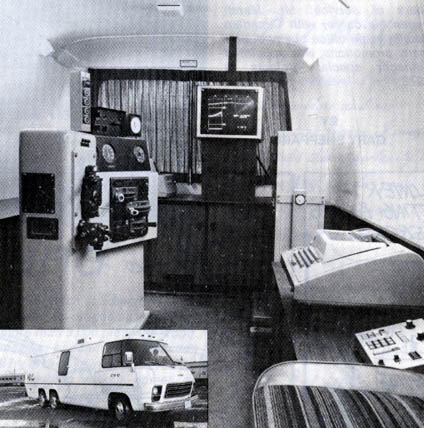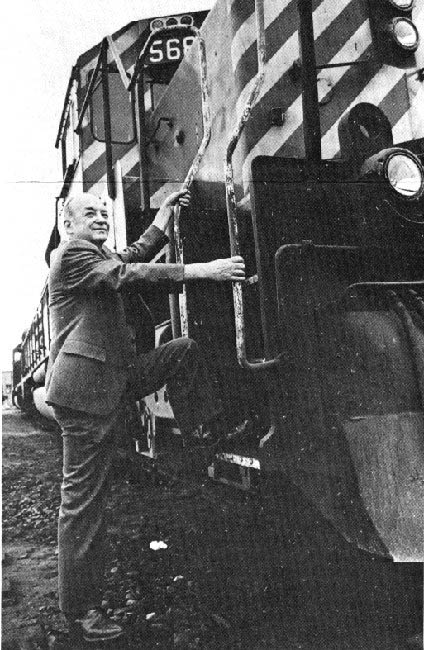
Public Relations and
Advertising Department
Windsor Station Montreal Que. H3C
3E4
|
|
Volume 11
Number 16
|
Dec. 9,
1981
|
Former Railroader has
Worn Many Hats
By Ralph
Wilson

Man and His
Machine: Dow William Alexander, who recently retired after 50 years with
CP Rail, is credited with introducing the train dynamics
simulator.
Lethbridge - Fifty years ago, a
13-year-old boy named Dow William Alexander strolled into the CPR
station at Frederiction Junction, N.B., his heart set on a job with the railroad.
He found one, all right - shovelling snow.
An inauspicious beginning perhaps, but from tiny acorns...
Since then, Mr. Alexander, who recently retired from CP Rail, has worn a whole
closet-full of railroading hats. He's worked as a telegrapher,
locomotive fireman, airbrake instructior, assistant superintendent, and
superintendent.
However, Mr. Alexander's most valued contribution to the railroad - aside from snow
removal - was his work in introducing a revolutionlry new railroading concept - the
train dynamics simulator.
The simulator, developed by Haliburton Services, of Duncan, Oklahoma, has proven an
invaluable tool in improving train handling and trouble-shooting
operating problems across the system.
"It was certainly a revolutionary concept", Mr. Alexander said during an
interview from his home here. "The first simulator on the market was obtained
by CP Rail and put into operation at Windsor Station in May, 1976."
TRAIN SIMULATOR
The system, based on a standard locomotive control panel, includes a microprocessor
equipped with two magnetic tapes - one storing data concerning the physical
characteristics of a railway subdivision. The other contains data compiled
by the local operator concerning specific train simulation.
In effect, the system accurately simulates train operation along a given stretch
of track.
"In actual operation", explained Mr. Alexander, "signals are
tranmitted from various items on the control stand and sent to the microprocessor.
Results are displayed on a TV screen, showing track profile, train movement, and
logitudinal in-train forces".
Given the display, along with a graphic illstration from a line printer,
locomotive engineers and trainees can obtain a firm grasp of preferred train
handling. In so doing, poor handling habits are reduced, making for more efficient
and safer train operation.
WELL ACCEPTED
In 1977, after initial tests, the simulator - and Mr. Alexander - went mobile,
introducing the simulator across the system.
"I was really surprised how well the system was accepted by the running trades.
With some engineers, it was almost impossible to keep them away from it. They were
coming back on their own time with their own ideas. If it worked on the simulator,
they'd try it out on the road", Mr. Alexander said.
In fact, he added, the only complaint received was that the simulator didn't remain
long enough at any one terminal.
"It was the men who suggested we should have a second system on the
road".
Soon after its introduction, the simulator also gained popularity with those
holding the purse strings.
"Six months after we put the simulator into the field we began to see results
from the information. There was a noticeable reduction in the number of derailments
where a cause wasn't readily recognized. Also, there was an unexplained reduction
in the number of freight claims.
"And, while the claims people had no explanation, I jumped right in and said
the reduction was due in part to the simulator and the better train handling that
resulted", he said.
Today, there are about 20 such simulators busily operating across North America.

This CP Rail News article is copyright 1981 by
Canadian Pacific Railway and is reprinted here with their permission. All
photographs, logos, and trademarks are the property of the Canadian
Pacific Railway Company.
|
|